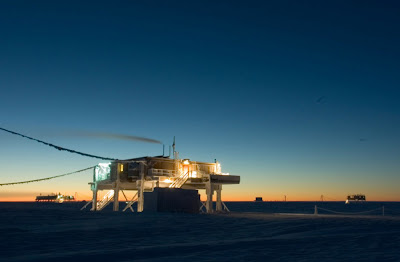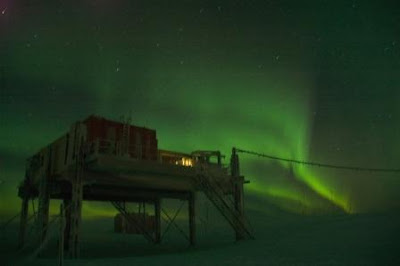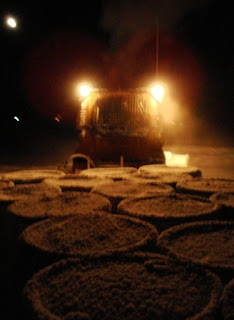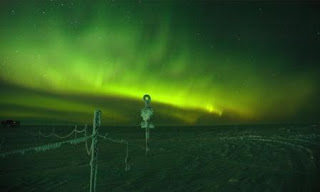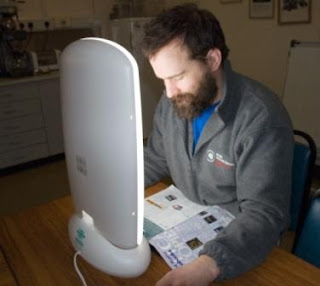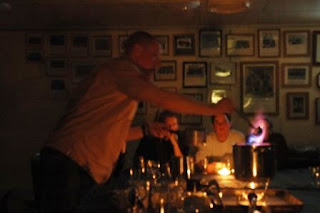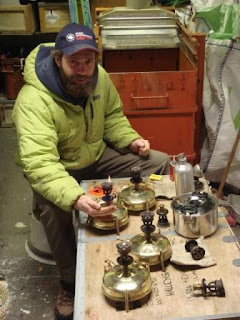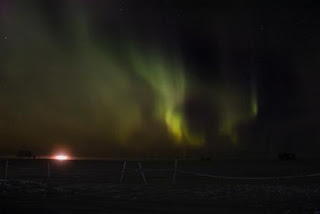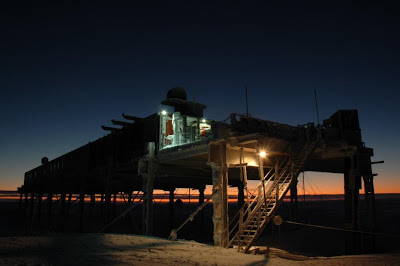Midwinter
Midday Over the Garage
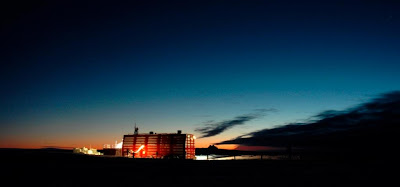
The winter solstice takes on a special significance for all of those in the Antarctic as it is supposedly the depth of the winter and a reminder that the sun and eventually fresh faces and fruit will return sooner than expected. In reality, we are yet to reach the halfway point until the influx of the summer team, which is still a few weeks away.
'Dozing the Melt Tank
On a weekly basis, when it is warm enough to run a 'dozer, the snow around the melt tank is 'dozed into a pile to make the digging over the week easier
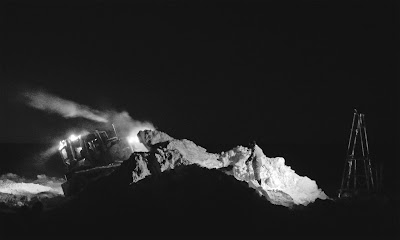
However, across the continent the week of Midwinter (the 21st June), is a time for celebration and on the BAS stations a week off to relax and party- as much as anyone can take time off, when there are still generators to be cared for, food to be cooked, met obs to be carried out and repairs on both science and domestic kit requiring immediate attention.
Sune and the Pyramid Tents in the Garage
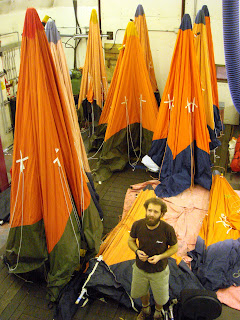
Prior to the Midwinter week, nonetheless, there is still work to be done. For Sune (Field Assistant), that means ensuring all the field kit is in good repair, as understandably nobody is keen on catastrophic tent failure in the middle of a storm on a summer field project, let alone the forthcoming winter trips when it frequently hits below -40°C, regardless of the rigorous contingency plans. Finding myself, fortunately, still short on medical work, I spent a few days taking apart and re-lashing these huge shelters, which would be impractical anywhere else in the world but are finely suited to the Antarctic climate.
Pete Celebrates His 50th Birthday
Photo thanks to Sune Tamm-Buckle

Notably, the run up to Midwinter, also marked Pete's (Z-Winter Base Commander), 50th birthday; the oldest member of the wintering team. An excuse for another cake making session for myself, as well as another party in the theme of Explorer's and Mountaineer's; all four members of the Met Team appeared roped up in Alpine Mountaineering style, causing them increasing problems as the evening progressed.
Before My Beard Was Tamed
A consequence of running around the perimeter in the cold- photo by Sune
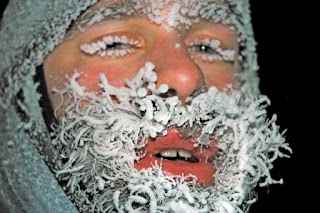
A week off did not mean a week in bed (for most at least), for from table-tennis to a competitive cross-country running there was plenty going on. I have always been fascinated by Nordic Biathlon (a punishing combination of cross-country skiing and shooting), so substituting snowballs for high-powered rifles, half the base turned out for a race, which not unsurprisingly given his Scandinavian roots and superior fitness, resulted in Sune trouncing the field.
Crazy Golf
Sune and Dean play a hole down the main Laws corridor
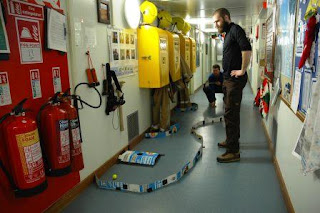
One of the traditions of Midwinter is the plethora of messages of goodwill between the various teams wintering across the Antarctic. Though there are significantly less than a thousand people in the Antarctic at the moment (a majority of them are at the American McMurdo base on the other side of the continent), our notice board is covered with photos and greetings from most of the bases scattered across the ice. Representing various nationalities from Ukrainian to Indian to French to Argentinian, they invariably include an invitation to dinner on the 21st June with the reassurance that a response is not expected.
Before the Midwinter's Day Meal
Photo by Dave Evans

The highlight of the week, is of course Midwinter's Day, though plenty were served breakfast in bed by the Base Commander, Ant (our outstanding chef) had been up since 6 as he had been for several days in a row, preparing the Midwinter dinner. Despite the lack of any fresh vegetables apart from onions, the multiple courses of stunning food meant that by the time we sat down for the Midwinter broadcast, everybody had eaten enough to last until the ship comes in.
Ant Preparing the Midwinter Meal
(Click on menu to enlarge) Photo courtesy of Tom Spiess
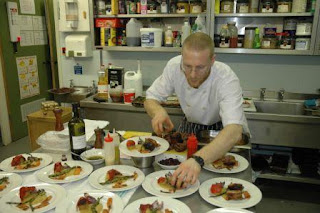

The BBC World Service transmits a Midwinter Broadcast each year destined for the four BAS bases composed mainly of messages from home. Despite the relative ease of communication now, as compared to even a few years ago, sitting as a group after dinner listening to the broadcast over our High Frequency (HF) radio is still a poignant experience, even if the message is, as mine was from my mother, a reassurance that if I fail to fit back into medicine in the UK, I can always do a bakery course instead- she has clearly not eaten any of my bread! The broadcast can be heard here.
Sastrugi Illuminated By The Sun

Each base chooses a song to accompany their messages, our choice of 'Echo Beach' by Martha and the Muffins (the song of the moment on base- even if it is from 1980), was definitely usurped by the team at KEP in South Georgia with The Muppet Song, while we all had visions of the four-member team on Bird Island dancing round their small base to their chosen 'YMCA'.
Celebrating Midwinter
Photo courtesy of Sune
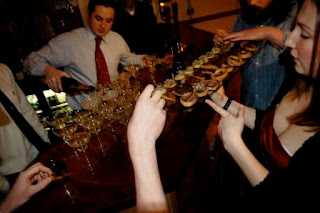
The other highlight of Midwinter is the exchange of presents; at dinner the night the last summerer left, we each drew the name of a base member from a hat, with the intention of making a gift for them for midwinter, with the recipients identity undisclosed until the day. Several months on and many furtive hours in the workshops, including some frenetic activity over the last few days, resulted in some spectacular pieces of work.
The Collected Midwinter Presents
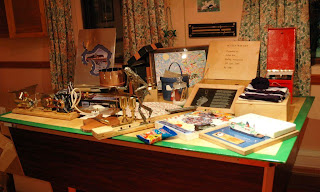
From a miniature brass model Primus stove correct to every detail, to pictures painted and framed on base, to a zoetrope, the range of presents produced, with the limited resources and large workshops can only reflect on everyones ingenuity. Andy Mac (Generator Mechanic), however, had an advisory role in a large number given his capacity to make or repair anything around base. I meanwhile received a stunning sculpture of a figure manhauling on skis around base, made for me by Mat (Vehicle Mech), from welding rods, a great reminder of one of the ways I particularly enjoy working around base.
Opening My Present
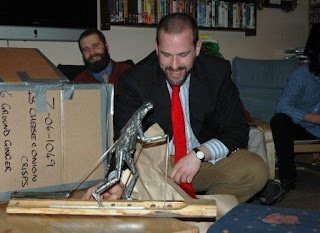
If you want to see the deserving overall winning entry in the base winter photo competition, follow this link. Dave's blog has some outstanding photos throughout.
As such, a week's holiday rapidly disappeared through the fingers. Halley is a spectacular place to be at this time of the year and I have to keep pinching myself to realise how beautiful a place it is and a great group of people to be here with.
The John Deere Tractors Stowed for the Winter
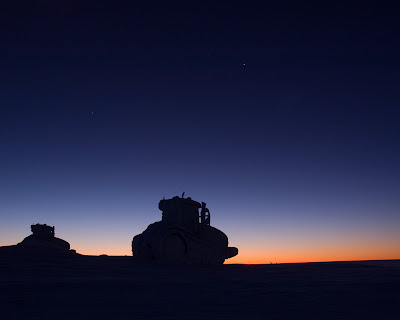

The winter solstice takes on a special significance for all of those in the Antarctic as it is supposedly the depth of the winter and a reminder that the sun and eventually fresh faces and fruit will return sooner than expected. In reality, we are yet to reach the halfway point until the influx of the summer team, which is still a few weeks away.
'Dozing the Melt Tank
On a weekly basis, when it is warm enough to run a 'dozer, the snow around the melt tank is 'dozed into a pile to make the digging over the week easier

However, across the continent the week of Midwinter (the 21st June), is a time for celebration and on the BAS stations a week off to relax and party- as much as anyone can take time off, when there are still generators to be cared for, food to be cooked, met obs to be carried out and repairs on both science and domestic kit requiring immediate attention.
Sune and the Pyramid Tents in the Garage

Prior to the Midwinter week, nonetheless, there is still work to be done. For Sune (Field Assistant), that means ensuring all the field kit is in good repair, as understandably nobody is keen on catastrophic tent failure in the middle of a storm on a summer field project, let alone the forthcoming winter trips when it frequently hits below -40°C, regardless of the rigorous contingency plans. Finding myself, fortunately, still short on medical work, I spent a few days taking apart and re-lashing these huge shelters, which would be impractical anywhere else in the world but are finely suited to the Antarctic climate.
Pete Celebrates His 50th Birthday
Photo thanks to Sune Tamm-Buckle

Notably, the run up to Midwinter, also marked Pete's (Z-Winter Base Commander), 50th birthday; the oldest member of the wintering team. An excuse for another cake making session for myself, as well as another party in the theme of Explorer's and Mountaineer's; all four members of the Met Team appeared roped up in Alpine Mountaineering style, causing them increasing problems as the evening progressed.
Before My Beard Was Tamed
A consequence of running around the perimeter in the cold- photo by Sune

A week off did not mean a week in bed (for most at least), for from table-tennis to a competitive cross-country running there was plenty going on. I have always been fascinated by Nordic Biathlon (a punishing combination of cross-country skiing and shooting), so substituting snowballs for high-powered rifles, half the base turned out for a race, which not unsurprisingly given his Scandinavian roots and superior fitness, resulted in Sune trouncing the field.
Crazy Golf
Sune and Dean play a hole down the main Laws corridor

One of the traditions of Midwinter is the plethora of messages of goodwill between the various teams wintering across the Antarctic. Though there are significantly less than a thousand people in the Antarctic at the moment (a majority of them are at the American McMurdo base on the other side of the continent), our notice board is covered with photos and greetings from most of the bases scattered across the ice. Representing various nationalities from Ukrainian to Indian to French to Argentinian, they invariably include an invitation to dinner on the 21st June with the reassurance that a response is not expected.
Before the Midwinter's Day Meal
Photo by Dave Evans

The highlight of the week, is of course Midwinter's Day, though plenty were served breakfast in bed by the Base Commander, Ant (our outstanding chef) had been up since 6 as he had been for several days in a row, preparing the Midwinter dinner. Despite the lack of any fresh vegetables apart from onions, the multiple courses of stunning food meant that by the time we sat down for the Midwinter broadcast, everybody had eaten enough to last until the ship comes in.
Ant Preparing the Midwinter Meal
(Click on menu to enlarge) Photo courtesy of Tom Spiess

The BBC World Service transmits a Midwinter Broadcast each year destined for the four BAS bases composed mainly of messages from home. Despite the relative ease of communication now, as compared to even a few years ago, sitting as a group after dinner listening to the broadcast over our High Frequency (HF) radio is still a poignant experience, even if the message is, as mine was from my mother, a reassurance that if I fail to fit back into medicine in the UK, I can always do a bakery course instead- she has clearly not eaten any of my bread! The broadcast can be heard here.
Sastrugi Illuminated By The Sun

Each base chooses a song to accompany their messages, our choice of 'Echo Beach' by Martha and the Muffins (the song of the moment on base- even if it is from 1980), was definitely usurped by the team at KEP in South Georgia with The Muppet Song, while we all had visions of the four-member team on Bird Island dancing round their small base to their chosen 'YMCA'.
Celebrating Midwinter
Photo courtesy of Sune

The other highlight of Midwinter is the exchange of presents; at dinner the night the last summerer left, we each drew the name of a base member from a hat, with the intention of making a gift for them for midwinter, with the recipients identity undisclosed until the day. Several months on and many furtive hours in the workshops, including some frenetic activity over the last few days, resulted in some spectacular pieces of work.
The Collected Midwinter Presents

From a miniature brass model Primus stove correct to every detail, to pictures painted and framed on base, to a zoetrope, the range of presents produced, with the limited resources and large workshops can only reflect on everyones ingenuity. Andy Mac (Generator Mechanic), however, had an advisory role in a large number given his capacity to make or repair anything around base. I meanwhile received a stunning sculpture of a figure manhauling on skis around base, made for me by Mat (Vehicle Mech), from welding rods, a great reminder of one of the ways I particularly enjoy working around base.
Opening My Present
If you want to see the deserving overall winning entry in the base winter photo competition, follow this link. Dave's blog has some outstanding photos throughout.
As such, a week's holiday rapidly disappeared through the fingers. Halley is a spectacular place to be at this time of the year and I have to keep pinching myself to realise how beautiful a place it is and a great group of people to be here with.
The John Deere Tractors Stowed for the Winter


